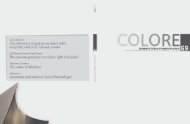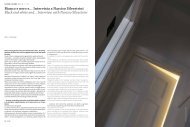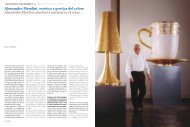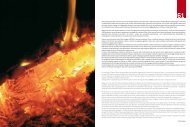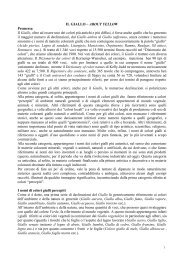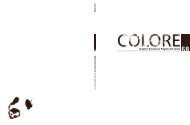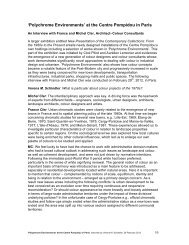Quaderni di Cultura e Progetto del Colore - Istituto Del Colore
Quaderni di Cultura e Progetto del Colore - Istituto Del Colore
Quaderni di Cultura e Progetto del Colore - Istituto Del Colore
Create successful ePaper yourself
Turn your PDF publications into a flip-book with our unique Google optimized e-Paper software.
CULTURA / CULTURE [ 1 2 (3 + 4) 5 6 ]<br />
Calce per il bianco, la Malachite o il Verderame per il verde, il Lapislazzuli<br />
per il blu, la Cocciniglia, la Terra rossa ecc. per il rosso ecc.), a parte<br />
il Rosa cartamo, estratto dal Carthamus Tinctorius , il Rosa <strong>di</strong> Tiro<br />
(Porpora <strong>di</strong> Tiro), l’Ocra rosa o la Terra rosa e pochi altri, per il Rosa<br />
bisogna aspettare l’era moderna, con i colori organici derivati dal<br />
catrame (Rosa Algol, Rosa Alizarina, Rosa Bengala, Rosa brillante,<br />
Rosa d’anilina, Rosa fucsina ecc.). Al solito, il fattore moltiplicatore dei<br />
colori rosa è dato dalle sue declinazioni (Rosa chiaro, Rosa brillante,<br />
Rosa cupo ecc.), dalle sue associazioni con altri nomi <strong>di</strong> colori (Bianco<br />
roseo, Rosa arancio, Rosa blu, Giallo rosato, Grigio rosato ecc.) o dalla<br />
combinazione dei due (Grigio rosato chiaro ecc.). Partito come un<br />
colore relativamente poco menzionato, nei <strong>di</strong>zionari dei colori, classici,<br />
grazie alle sue declinazioni e all’apertura ai nomi <strong>di</strong> fantasia, il rosa si<br />
moltiplica come tutti gli altri colori, rendendo attuale l’osservazione <strong>del</strong><br />
grande specialista dei colori J.G.Vibert nel suo trattato La science de la<br />
peinture <strong>del</strong> 1902: On est encore loin d’avoir épuisé tous le noms des<br />
pierres précieuses, des fleurs, des villes, d’oiseaux, dont se compose<br />
le vocabulaire des marchands de couleurs . Nel “<strong>di</strong>zionario” allegato,<br />
mostreremo una campionatura <strong>del</strong>le principali tipologie <strong>di</strong> colori Rosa<br />
sopra menzionate.<br />
Pink rosa (Rose pink)<br />
Philip Ball, nel suo brillante saggio <strong>Colore</strong>.Una biografia, riferisce che<br />
il Pink rosa era ricavato dal legno <strong>di</strong> brasile e che il “pink” dopo il XIX<br />
Secolo <strong>di</strong>venta gradualmente sinonimo <strong>di</strong> rosso chiaro e dunque <strong>di</strong> “pink<br />
rosa”, mentre fino ad allora pink era un pigmento dalle provenienze, dai<br />
meto<strong>di</strong> <strong>di</strong> sintesi e dalle ricette <strong>di</strong>verse, per cui esistevano anche pink<br />
ver<strong>di</strong> e pink marroni, oltre che pink rosa. Nei <strong>di</strong>zionari dei colori, il pink<br />
rosa oscilla tra il Rosa forte, il Rosa me<strong>di</strong>o, il Rosa purpureo chiaro e il<br />
rosso purpureo vivo, passando attraverso l’Arancio rossastro intenso.<br />
Notazioni: Munsell: 4.6RP 8.0/5.5; NCS: S 7020-R30B.<br />
Denominazioni ISCC.NBS: 249 – Rosa purpureo chiaro (light purplish<br />
Pink).<br />
Rosa (Pink, Rose)<br />
Il nome <strong>di</strong> questo colore si riferisce al fiore omonimo e comprende le<br />
varianti chiare <strong>del</strong> rosso-bluastro e <strong>del</strong> porpora. In inglese, “Rosa” viene<br />
definito sia come Rose che come Pink, che deriva dalla denominazione<br />
inglese <strong>di</strong> garofano. Notazioni: Munsell: 2.8R 7.2/5.3; NCS: S 1030-R.<br />
Denominazione ISCC.NBS: 5 – Rosa me<strong>di</strong>o (moderate Pink).<br />
Rosa antico (Old rose, Antique rose, Old pink)<br />
Sinonimo <strong>di</strong> Rosa vecchio, Rosa sbia<strong>di</strong>to, <strong>Colore</strong> <strong>di</strong> rosa secca, Rosa<br />
appassita, Foglia <strong>di</strong> rosa vecchia, Foglia morta rosa ecc. Il termine,<br />
molto in voga nell’800, è attualmente in <strong>di</strong>suso.<br />
Notazioni: Munsell: 4.0R 4.4/4.8; NCS: S 4020-R.<br />
Denominazione ISCC.NBS: 19 – Rosa me<strong>di</strong>o (grayish Red).<br />
Rosa Bengala (Bengale rose).<br />
<strong>Colore</strong> organico derivato dal catrame <strong>di</strong> carbone, scoperto e prodotto,<br />
secondo il Ball, tra il 1870 e il 1880 . E’ il colore più bluastro <strong>di</strong> tutta<br />
la serie <strong>di</strong> tutta la serie <strong>del</strong>le eosine e dà il colore più brillante. Il<br />
Répertoire des couleurs lo considera sinonimo <strong>del</strong> colore Rosa La<br />
Francia, riproduzione <strong>del</strong> Roseus <strong>del</strong> Professor Saccardo, attribuendogli<br />
lazuli for blue, Cochineal, Red Earth for red etc.), a part from Safflower<br />
Rose, extracted from Carthamus Tinctorius , Tyrian Pink (Tyrian<br />
Purple), Ochre Rose or Earth Rose and few others, we have to wait the<br />
modern era for pink, with the organic colourings derived from coal tar<br />
(Algol Rose, Alizarin Rose, Bengalese Rose, Brilliant Rose, Aniline Rose,<br />
Fuchsine Rose etc.). As usual, the multiplying factor of pink colours<br />
depends on their variations (Light Pink, Brilliant Pink, Dark Pink etc.),<br />
their associations with other colour names (Rosy White, Orange Pink,<br />
Blue Rose, Rosy Yellow, Rosy Grey etc.) or the combination of these two<br />
factors (Light Rosy Grey etc.). Started as a relatively poorly cited colour,<br />
at least in classical <strong>di</strong>ctionaries of colours, thanks to its variations and<br />
the opened way to fantasy names, pink multiplies as all other colours<br />
do, bringing up to date the sentence of great colour specialist J.G.Vibert<br />
in his treaty La science de la peinture of 1902: On est encore loin<br />
d’avoir épuisé tous le noms des pierres précieuses, des fleurs, des<br />
villes, d’oiseaux, dont se compose le vocabulaire des marchands de<br />
couleurs . In the attached “<strong>di</strong>ctionary”, we show a range of samples of<br />
the main types of pink colour mentioned above.<br />
Rose Pink<br />
Philip Ball, in his brilliant essay Colour. A biography, says that Rose Pink<br />
was obtained from Brazilian wood and that “pink”, after the Nineteenth<br />
Century, becomes gradually synonym of light red and therefore of “ pink<br />
rose”, while until then pink was a pigment of <strong>di</strong>fferent origins, synthesis<br />
methods and formulas, and for that reason there were also green pink<br />
and brown pink , other than rose pink. In <strong>di</strong>ctionaries of colours, rose<br />
pink ranges from Strong Pink, Moderate Pink to Light Purple Rose and<br />
Bright Purple Red, passing trough Strong Red<strong>di</strong>sh Orange.<br />
Munsell notation: 4.6RP 8.0/5.5; NCS: S 7020-R30B.<br />
ISCC.NBS designation: 249 –Light Purplish Pink.<br />
Pink, Rose<br />
The name of this colour is related to the homonymous flower and<br />
includes the light variants of bluish-red and purple. In English, Rose is<br />
also called Pink, which has its origin in the English term “pinks” once<br />
defining plants from the Dianthus genus.<br />
Munsell notation: 2.8R 7.2/5.3; NCS: S 1030-R.<br />
ISCC.NBS designation: 5 –Moderate Pink.<br />
Old Rose, Antique Rose, Old Pink<br />
Synonym of Faded Rose, Dried Rose Colour, Withered Rose, Old Rose<br />
Leaf, Dead Rose Leaf etc. The term, much in vogue during the 19 th<br />
Century , is nowadays fallen into <strong>di</strong>suse.<br />
Munsell notation: 4.0R 4.4/4.8; NCS: S 4020-R.<br />
ISCC.NBS designation: 19 –Greyish Red.<br />
Bengaline Rose.<br />
Organic colour derived from coal tar, <strong>di</strong>scovered and produced,<br />
accor<strong>di</strong>ng to Ball, between 1870 and 1880. It is the most bluish colour<br />
of all the eosins and also gives the most brilliant colour. Répertoire des<br />
couleurs considers it synonym of French Rose colour, a reproduction<br />
of Professor Saccardo’s Roseus, giving it light red<strong>di</strong>sh lilac colour<br />
designation.<br />
il colore lilla rossastro pallido.<br />
Notazioni: Munsell: 7.6RP 4.9/13.6; NCS: S17070-R20B.<br />
Denominazioni ISCC.NBS: 249 – Rosso purpureo vivo (vivi<strong>di</strong> purplish<br />
Red).<br />
Rosa carne (Flesh pink)<br />
Rosa tendente al colore <strong>del</strong>la carne, tra il colore “Incarnato” (riproduzione<br />
<strong>del</strong>l’Incarnatus <strong>del</strong> professor Saccardo), corrispondente alla tonalità<br />
generale <strong>del</strong> crisantemo rosa, e quello <strong>del</strong>la rosa denominata “Baronessa<br />
Henriette-Snoy”.<br />
Notazioni: Munsell: 4.2YR 8.6/2.2; NCS: S 1010-Y70R.<br />
Denominazione ISCC.NBS: 31 – Rosa giallastro pallido (pale yellowish<br />
Pink).<br />
Rosa cartamo (Carthamus rose)<br />
Nome commerciale <strong>del</strong> colore ottenuto dalla cartamina (materia<br />
colorante estratta dal Carthamus lanatus ). Tra i sinonimi, il Répertoire<br />
des couleurs cita il Rosa Atlas, mentre il Dictionary of color names <strong>di</strong><br />
Kelly-Judd lo assimila al <strong>Colore</strong> Artiglieria.<br />
Notazioni: Munsell:5 0.R 4.9/15.4; NCS: S 1070-Y90R.<br />
Denominazione ISCC.NBS: 11 – purpureo forte (strong purplish Red).<br />
Rosa cinese (China rose)<br />
Il Rosa cinese o Rosa <strong>di</strong> Cina, dal colore rosso purpureo forte, per il<br />
Vibert, è una denominazione generica dei ven<strong>di</strong>tori <strong>di</strong> colori<br />
Notazioni: Munsell: 7.3RP 4.4/11.4; NCS: S 2065-R20B.<br />
Denominazione ISCC.NBS: 255 – Rosso purpureo forte (strong purplish<br />
Red).<br />
Rosa coloniale (Colonial rose)<br />
Definito dal Dictionary of color <strong>di</strong> Maerz and Paul come Rosso grigiastro<br />
chiaro o Rosso grigiastro.<br />
Notazioni: Munsell: 4.2YR 8.6/2.2; NCS: S 1010-Y70R.<br />
Denominazione ISCC.NBS: 31 – Rosa giallastro pallido (pale yellowish<br />
Pink).<br />
Rosa <strong>di</strong> Baveno (Baveno pink)<br />
Il nome prende origine dal granito rosa omonimo, denominato anche<br />
Granito roseo chiaro o Miarolo rosa, le cui cave furono aperte verso la<br />
metà <strong>del</strong> secolo XVI. E’ molto elegante e quin<strong>di</strong> pregiato non solo per la<br />
sua grana regolare, ma specialmente per la simpatica tinta rosata <strong>del</strong><br />
suo feldspato (Federico Sacco).<br />
Notazioni: Munsell: 2.5YR 6/2 (Datacolor); NCS: S 4010-Y70R.<br />
Denominazione ISCC.NBS: 32 – Rosa giallastro grigiastro (grayish<br />
yellowish Pink).<br />
Rosa <strong>di</strong> macchia (Eglantine)<br />
I colori Rosa <strong>di</strong> macchia o Rosa canina Rosa <strong>di</strong> rosa o Rosa Eglantina o<br />
semplicemente Eglantina sono sinonimi.<br />
Essi ricordano i colori dei fiori <strong>del</strong>le eglantine selvatiche e il colore Rosa<br />
Eglantina era noto come colore <strong>di</strong> tessuti.<br />
Notazioni: Munsell: 4.4RP 6.0/12.2; NCS: S 1050-R20B.<br />
Denominazione ISCC.NBS: 248 – Rosa purpureo intenso (deep<br />
...selezione dai rosa / ...pink selection<br />
Munsell notation: 7.6RP 4.9/13.6; NCS: S17070-R20B.<br />
ISCC.NBS designation: 249 – Vivid Purplish Red.<br />
Flesh Pink<br />
It is similar to flesh colour, between “Carnation” (reproduction of<br />
Professor Saccardo’s Incarnatus), correspon<strong>di</strong>ng to the generic hue<br />
of pink chrysanthemum, and the colour of “Henriette-Snoy Baroness”<br />
rose flower.<br />
Munsell notation: 4.2YR 8.6/2.2; NCS: S 1010-Y70R.<br />
ISCC.NBS designation: 31 –Pale Yellowish Pink.<br />
Carthamus Rose<br />
It is the commercial name of the colour obtained from safflower<br />
extract (colouring matter obtained from Carthamus lanatus ). Among<br />
synonyms, Répertoire des couleurs cites Atlas Rose, while Kelly-Judd’s<br />
Dictionary of colour names assimilates it to Artillery Colour.<br />
Munsell notation:5 0.R 4.9/15.4; NCS: S 1070-Y90R.<br />
ISCC.NBS designation: 11 –Strong Purplish Red.<br />
China Rose<br />
Chinese Rose or China Rose, characterized by a strong red<strong>di</strong>sh purple<br />
colour, accor<strong>di</strong>ng to Vibert, is a generic designation of colours sellers.<br />
Munsell notation: 7.3RP 4.4/11.4; NCS: S 2065-R20B.<br />
ISCC.NBS designation: 255 –Strong Purplish Red.<br />
Colonial Rose<br />
Defined by Dictionary of colour by Maerz and Paul as Light Greyish Red<br />
or Greyish Red.<br />
Munsell notation: 4.2YR 8.6/2.2; NCS: S 1010-Y70R.<br />
ISCC.NBS designation: 31 –Pale Yellowish Pink.<br />
Baveno Pink<br />
The name takes its origin from the homonymous pink granite, also<br />
called light rosy granite or Miarolo pink granite, the stone pits of which<br />
were opened around the middle 17 th Century. It is very elegant and<br />
therefore prized not only for its regular grain, but especially for the nice<br />
rose hue of its feldspar (Federico Sacco).<br />
Munsell notation: 2.5YR 6/2 (Datacolor); NCS: S 4010-Y70R.<br />
ISCC.NBS designation: 32 – Greyish Yellowish Pink.<br />
Eglantine<br />
The colours Wild Rose Pink, Eglantine Rose or simply Eglantine are<br />
synonyms.<br />
They recall the wild eglantine flowers colour and Eglantine Pink was<br />
common as name for fabrics colour.<br />
Munsel notation: 4.4RP 6.0/12.2; NCS: S 1050-R20B.<br />
ISCC.NBS designation: 248 –Deep Purplish Pink.<br />
Neyron Rose<br />
Generic colour of the rose flower known as Paul Neyron rose.<br />
Munsell notation: 7.6RP 4.9/13.6; NCS: S 1070-R20B.<br />
ISCC.NBS designation: 254 –Vivid Purplish Red.<br />
26 COLORE<br />
COLORE 27<br />
Alessandro D'Adda, Convolutions






